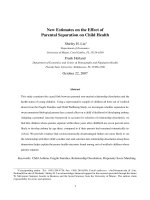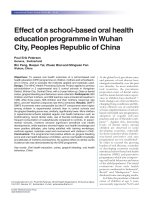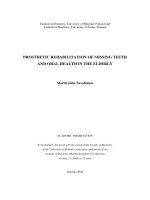The Effectiveness of Computer Based Interactive Oral Health Education docx
Bạn đang xem bản rút gọn của tài liệu. Xem và tải ngay bản đầy đủ của tài liệu tại đây (9.26 MB, 198 trang )
1
The Effectiveness of Computer Based Interactive Oral
Health Education.
Colm Rice BSc. BDS.
Submitted in fulfilment of the requirement of the degree of Master of Medical Science
(Medical Science)
in the Faculty of Medicine at the University of Glasgow April 2009.
2
Table of Contents
Reference for tables 7
Reference for figures 8
Acknowledgements 9
Declaration 10
Synopsis 11
Chapter 1 14
Literature Review 14
[1.1] Scotland’s dental health 15
[1.1.1] Caries in relation to diet 16
[1.2] Sample population 16
[1.2.1] Caries rates 16
[1.2.2] Low dental registration 17
[1.2.3] Key psychological stage of development 17
[1.2.4] Pester Power 17
[1.2.5] Why education is important so young 18
[1.3] The integration of Oral Health into the primary school curriculum 18
[1.4] Psychology of learning 20
[1.4.1] A brief history of learning 20
[1.4.2] Piaget theories on child development 20
[1.4.3] Vygotsky, the zone of proximal development and scaffolding 21
[1.5] Technology 23
[1.5.1] The impact of computer use on young children 23
[1.5.2] Computers in the classroom 24
[1.5.3] Computers and control. 25
[1.5.4] Children‟s social interactions with computers 25
[1.5.5] Computers affect on language development. 26
[1.6] Difficulties in designing software for children 26
[1.7] Interactive components of design 27
[1.7.1] Rationale for the development of an avatar 27
[1.7.2] Social interactions 27
[1.8] Educational technologies 28
[1.8.1] Why make education a game? 28
[1.8.2] Interactive programmes as pedagogic platforms. 29
[1.8.3] The developing use of interactive technologies in health education. 31
3
[1.8.4] Interactive technology verses traditional education material. 31
[1.8.5] Interactive Oral Health and Nutrition Programmes 34
[1.8.6] Recent developments in interactive education. 35
[1.8.7] Is interactive computer based education the way forward? 36
[1.9] Summary of Literature review 37
Chapter 2 38
Aims. 39
[2.1] Primary aim 39
[2.2] Secondary aim 39
[2.3] Null Hypothesis 39
Chapter 3 40
Interactive Computer programme Development 40
[3.1] Introduction to interactive computer design 41
[3.2] Development of the core programme. 42
[3.3] Needs analysis 42
[3.3.1] Needs analysis for the adult 42
[3.3.2] Needs analysis for the child 42
[3.4] Selection of an avatar for the computer programme 43
[3.4.1] The ideas of concrete manipulatives 43
[3.4.2] Advantages in the use of a physical character to augment program interface 44
[3.4.3] Use of familiar characters 44
[3.4.4] Development of Play (freestanding) and Role play in reinforcement 44
[3.5] Development of the physical programme. 45
[3.5.1] Childsmile Programme 45
[3.5.2] Health Education Programme 5-14 (Level A) 46
[3.5.3] Information technology programme for 5-14 (level A) 46
[3.5.4] Story board 47
[3.6] Animation development 48
[3.7] Educational components development 51
[3.7.1] Selection presentation 51
[3.7.2] Selection between five food options 52
[3.7.3] Selection between two food options 54
[3.8] Supporting “accessory” programmes 56
[3.8.1] Catch a fairy 56
[3.8.2] Tooth brushing 57
[3.8.3] Snack safe 57
4
[3.9] Avatar development 58
[3.9.1] Vocal recording 58
[3.10] Conclusion 59
Chapter 4 60
Qualitative study: Dental team, Dieticians and School teachers 60
[4.1] Aim 61
[4.2] Method 62
[4.2.1] Peer group 62
[4.2.2] Structured one to one interview 62
[4.3] Results 63
[4.3.1] Results from the Dental staff 63
[4.3.2] Results from the Dieticians 63
[4.3.3] Results from the Teaching staff 64
[4.4] Discussion 66
[4.4.1] Function and practicality 66
[4.4.2] Script and content 68
[4.4.3] Miscellaneous 69
[4.5] Resultant changes to the programme 70
[4.5.1] Functionality and practicality 70
[4.5.2] Script and content 71
[4.5.3] Miscellaneous comments 71
[4.6] Conclusion 74
Chapter 5 75
Qualitative study; User group assessment 75
[5.1] Aim 76
[5.2] Method 77
[5.2.1] Sample population 77
[5.2.2] Functionality and practicality 77
[5.2.3] Assessment by direct and recorded observation 78
[5.2.4] Structured interview with the teacher 80
[5.2.5] Structured interview with the children 80
[5.3] Results 81
[5.3.1] Results from functionality 81
[5.3.2] Results from the direct visual observation 83
[5.3.3] Recorded results from observed interactions 84
[5.3.4] Results from the structured discussion with the teacher 88
5
[5.3.5] Results from the structured discussion with the children 88
[5.4] Resultant changes to programme 89
[5.4.1] Functional changes to programme format 89
[5.4.2] Interaction alterations 93
[5.4.3] Navigation alterations 93
[5.4.4] Script and content alterations 93
[5.4.5] Further alterations 93
Chapter 6 94
Pilot study 94
[6.1] Aims 95
[6.2] Method 96
[6.2.1] Population randomisation and blinding 96
[6.3] Programme use and Data collection 97
[6.3.1] Programme use and accessibility 97
[6.3.2] Time frame for data collection 98
[6.3.3] Assessment tool 98
[6.4] Results 99
[6.4.1] Sample 99
[6.4.2] Food identification results 100
[6.4.3] Recording of actual lunch snack 101
[6.5] Discussion 102
[6.5.1] Population, randomization, blinding 102
[6.5.2] Programme use and data collection 102
[6.6] Resultant changes 103
Chapter 7 104
An evaluation of the interactive computer programme to facilitate the identification
of healthy foods: A randomized controlled trial. 104
[7.1] Aims 105
[7.2] Method 106
[7.2.1] Sample 106
[7.2.2] Ethical approval 107
[7.2.3] Education department approval 107
[7.2.4] Consent 107
[7.2.5] Randomisation blinding and concealment 107
[7.2.6] Data collection 108
[7.3] Results 109
[7.3.1] Sample demographics 109
6
[7.3.2] The results are presented as follows 111
[7.3.3] Identification of healthy and unhealthy food stuffs 111
[7.3.4] Comparison between groups in relation to healthy food identification 114
[7.3.5] Recording of actual playtime snack 118
[7.4] Summary of results 119
Chapter 8 120
Discussion 120
[8.1] General Discussion 121
[8.1.1] Results in relation to other comparative studies 122
[8.1.2] The efficacy of traditional paper based education material 122
[8.2] Control group educational materials 123
[8.2.1] The effects of Interactivity 124
[8.3] The range of ability of the participants 125
[8.4] Benefit of a blank control group 126
[8.5] Health Education 127
[8.6] Limitations of the programme 129
[8.7] Accessory programmes 129
[8.8] Assessment tool 130
[8.9] Playtime snack or “Play piece” selection 131
[8.10] Contamination 133
[8.10.1] Contamination between the control and intervention group 134
[8.11] Future Study 134
[8.11.1] Subjective analysis 134
[8.11.2] Comparative study of interactivity 135
[8.11.3] Improvements to the interactive computer programme 136
[8.12] Summary 137
Chapter 9 138
Conclusion 138
[9.1] Conclusion: 139
[9.1.1] Primary conclusion 139
[9.1.2] Secondary conclusion 139
[9.2] Null hypothesis 139
References
Abstracts
Appendices
7
Reference for tables
Page
Table 1.1 Principles of good pedagogy and parallels in an interactive game
environment.
Table 4.1 Correlation of important elements derived from structured
interviews.
Table 5.1 Table used to record irregularities and errors in the programme
function.
Table 5.2 Table used to record the interactivity of the children with the
computer programme.
Table 5.3 This table shows an example of recorded computer errors.
Table 5.4 Recorded results from direct observation on Day1 and Day 7.
Table 5.5 Recorded results from direct observation on Day1 and Day 7.
Table 5.6 Recorded results from direct observation on Day1 and Day 7.
Table 6.1 Demographics of the pilot study recruits
Table 6.2 Food identification scores, Base line Day 1 and Day 7 results.
Table 6.3 Actual snacks at baseline at one week.
Table 7.1 Group Demographics.
Table 7.2 Table shows the tabulated results for the control trial.
Table 7.3 Results for the change in score over the time period in each group.
Table 7.4 Shows the value attributed to the snacks drawn by the children.
Table 7.5 Summary of results for snack selection.
30
65
79
79
82
85
86
87
99
100
101
109
115
116
118
119
8
Reference for figures
Page
Figure 3.1 Flow diagram of programme.
Figure 3.2 Barney the dog.
Figure 3.3 Subsidiary characters; Cat and Children.
Figure 3.4 Plane background selected for programme.
Figure 3.5 The basic screen including the navigation buttons.
Figure 3.6 Flow diagram of five choice selection cascade.
Figure 3.7 The initial screen shot shows the food stuffs available for selection.
Figure 3.8 Flow diagram of two choice selection cascade.
Figure 3.9 The two choice cascade system.
Figure 3.10 The original digital images used in development of the avatar.
Figure 3.11 The adapted and digitally enhanced animated version of the final
avatar.
Figure 4.1 The original programme linear format.
Figure 4.2 The revised programme format to accommodate time restraints.
Figure 4.3 The screen representations of the revised format.
Figure 5.1 Flow diagram of sequenced programme format.
Figure 5.2 Flow diagram of sequence including Easy/Hard division.
Figure 5.3 Flow diagram of finalized programme format.
Figure 5.4 Screen shots representing the branching to Hard/Easy levels.
Figure 7.1 Consort flow chart.
Figure 7.2 Control group taken at; Baseline, three weeks and three months.
Figure 7.3 Intervention group taken at; Baseline, three weeks and three
months.
Figure 7.4 Box plot graph shows the actual score at all three assessment
points for controls and Intervention groups.
47
48
49
49
50
52
53
54
55
60
60
72
72
73
89
90
91
92
110
112
113
117
9
Acknowledgements
Thanks to Kay Minty and all the children of Sandwick Hill Primary School for making this
research both fun and rewarding.
Thanks also to Siobhan McHugh for her help and statistical advice.
Thanks to my fiancée Donna for all her help and support throughout this research.
Thanks to Pat for all her help with proof reading and her boundless encouragement.
I would especially like to thank Professor Marie-Therese Hosey for her constant energy,
enthusiasm and her endless patience. Thank you for the time and commitment you have
shown me.
10
Declaration
This thesis represents the original work of the author.
“The Effectiveness of Computer Based Interactive Oral Health Education.”
Colm Rice BSc BDS
April 2009
11
Synopsis
The Western Isles of Scotland have historically high levels of dental disease in the five
year old age group amongst the worst in the UK. The “Action Plan for Scotland” has
implemented a multidisciplinary approach to deal with this problem. This includes a major
role for schools in supporting and improving oral health, by reducing the availability of
cariogenic produce in schools and actively promoting healthier diets.
In light of this the researcher created an interactive computer programme, designed to
educate children about healthy eating and improve their ability to identify cariogenic
foods. The interactive computer programme was designed to integrate into the school
curriculum providing a combined teaching tool and learning resource; for elements of both
the health curriculum and IT attainment targets.
To assess the efficacy of the interactive computer programme a blind randomised
controlled trial was designed to measure:
Its ability to teach children the difference between healthy and unhealthy food.
If it could positively influence the children‟s selection of playtime snack.
The computer programme was initially assessed by a peer group consisting of Primary
School Teachers, Dental staff (Glasgow University Dental School) and Dieticians
(Western Isles Health Board). This was to ensure the content contained the correct
nutritional and oral health message and that the interactive computer programme was
educationally appropriate, for the age group within the study.
12
The computer programme was then assessed by a user group, consisting of pupils from
Sandwick Hill Primary School, aged from four and a half to seven. Changes were then
made in relation to the format and content of the programme to improve and refine it.
An initial pilot study was undertaken within Sandwick Hill Primary School to assess the
methodology of the controlled trial and the randomisation and blinding of the participants.
This also allowed refinement of the assessment tool to be used within the study. The
assessment tool was designed to determine the children‟s ability to identify healthy and
unhealthy foods and to record their playtime snack.
Two schools were involved in the controlled trial, Stornoway Primary School and Laxdale
Primary School. Positive consent was received for Eighty-six pupils in total. There were
forty five boys (52.3%) and forty one girls (47.7%). The mean age was 5.7, (range 4 to 7
years). The teaching staff involved within the study were given a tutorial to explain the use
of the programme and the protocols relating to randomisation and blinding. The
participants were then randomly allocated to one of two groups, the intervention or control
group. Both groups were then assessed to provide a comparative baseline. The intervention
group were provided with the interactive computer programme. They were to use the
programme for fifteen minutes a time over three weeks. The teachers were encouraged to
allow the children to access the programme at least five to six times during this period. The
control group were provided with traditional paper based educational material which was
completed during class time. After three weeks the children were reassessed and the
educational materials removed. The children were then assessed again after three months
to assess longevity and retention of the acquired knowledge. The researcher remained blind
to group allocation until the key was broken after analysis of the results.
13
Regarding identification of healthy food, regression analysis showed significant
improvement in both groups, but t-tests revealed no significant difference between them.
The groups matched well at baseline [Two- Sample T-test for means, p=0.979 95% CI -
4.88, 4.76]; the intervention group showed greater improvement at 3 weeks but this was
not significant [Two- Sample T-test for means, p= 0.135 95% CI -7.56, 1.04]. There was
no difference seen at 3 months [Two- Sample T-test for means. P= 0.547, 95% CI -5.12,
2.74]. There was neither an improvement nor a difference between the two groups in
snack selection.
This study provides evidence as to the effectiveness of interactive technology in relation
to oral health education. It shows that interactive computer technology can provide an
alternative to paper based educational materials. This study does not however show it to
be significantly more effective. The study also shows that the use of the interactive
computer programme was ineffective in modifying behaviour, in relation to diet, in this
age group.
14
Chapter 1
Literature Review
15
[1.1] Scotland’s dental health
Within Europe, Scotland‟s dental health is ranked as one of the worst and the Western Isles
specifically, is an area of serious concern (NDIP 2003). There have been many reasons
suggested for the poor oral health of the Islands, the challenging economic circumstances,
low socioeconomic status of the area (Pitts et al 2006, Carstairs 1995) and the difficulty in
accessing dental health services (Nuttal et al 2006, Bentley et al 1983). This has all
combined to produce a challenging and complex oral health problem, the multi-factorial
nature of which means that the solution can never be a simple one.
In an attempt to address these problems the Scottish government has put into place, “The
Oral Health Strategy for Scotland.” The aim is to transform the oral health of children, who
are most at risk, through early intervention with support and education (Forgie 2005,
Bentley et al 1983). The dental health improvement programme encourages the
development of a multidisciplinary approach to the improvement of child dental health,
with the inclusion of parents and extended families, health visitors, teachers, care workers
and other professionals.
At the core of the dental health strategy is the education of the individual to improve oral
health. Kay and Locker, (1998) found that the early adoption of healthier attitudes created
better long-term health benefits. In view of this the author has developed an interactive
computer package for use in schools with children aged four to six years. The programme
is designed to improve the children‟s understanding of oral health and diet and, most
importantly, recognition of cariogenic foods.
16
[1.1.1] Caries in relation to diet
The importance of well maintained oral hygiene and reduction of dietary intake of extrinsic
non-milk sugars are accepted preventive factors (Pitts et al 2006, Chapman et al 2006,
Gibson and Williams 1999). Work by Loveren and Duggal, (2004) questioned fifty four
European experts from twenty different countries on the role of diet in caries prevention.
All fifty four of the experts and all of the national guidelines mentioned “reduction of the
frequency of cariogenic intakes” as the principle dietary measure for caries prevention. It
was acknowledged within the study that, it would be unrealistic to assume people would
reduce their frequency of snacking to zero, but reducing the cariogenicity of these snacks is
crucial in terms of caries prevention. It was also considered more appropriate to promote a
generally healthy balanced diet and moderate snacking frequency with healthier options.
Well maintained oral hygiene and the use of fluoride toothpastes were also mentioned as
equally important features of caries prevention and the inclusion of these features within
the computer programme was important.
[1.2] Sample population
The key focus group for this thesis is children in Primary one and two (age range four to
six years). This age group was selected for several reasons.
[1.2.1] Caries rates
In the Western Isles the rate of caries within five year olds over the last twenty five years
has been very high and amongst the worst in Scotland. This is concerning as the latest UK
reports (Pitts et al 2006, Nuttal et al 2006) have shown a stagnant level of caries within this
age group and an apparent failure to resolve the issues of early childhood caries. Moreover,
17
a reduction in treatment of this caries is leading to a pool of untreated decay within this
population.
[1.2.2]Low dental registration
Within the Western Isles, there are very low levels of dental registration only 29% of five
years olds were registered with a GDP (general dental practitioner) in 2003. The remaining
children were dependant on the community service to provide their treatment and care.
This high risk group are traditionally poor attendees and more likely to develop chronic
disease as a result of inequalities in access and care (Gussy et al 2006, Health Scotland
2007).
[1.2.3] Key psychological stage of development
At this stage of development children in Primary one and two have acquired interactive
skills and a degree of self awareness (Piaget 1955). As such, it is appropriate to introduce
the ideas about healthy eating and caring for themselves. This age is also characterised by
an important transitional period during which the children should be encouraged to learn
and stretch their abilities (Boeree 2006).
[1.2.4] Pester power
The child has a role in the family unit. As such, children are becoming increasingly
involved in the decision making processes that occur within the average household, this
often includes what the child eats. It has been shown that by the age of seven years
children have developed significant bargaining and negotiating skills (Harbaugh et al 2007,
Robinson 2000). This was seen to be evident in an investigation of lunch box contents by
Dental Health Educators in Manchester (Roberts et al 2003) who found that children aged
four to seven years had nutritionally better lunches than those of older children aged seven
18
to eleven years. The latter contained a much higher frequency of crisps, chocolate and
fizzy drinks. This was also reflected in comparative studies to assess the nutritional value
of children‟s lunchboxes, the results showed the contents had increased saturated fat levels,
salt and sugar levels (Rogers et al 2007, Griffin and Barker 2008, Ruxton and Kirk 1996).
As a child‟s ability to exert pressure and influence over their parents increases, parental
control of the diet is undermined leading to a deterioration of the diet (Roberts et al 2003).
It is important therefore to educate younger children before they begin to influence the
parents‟ decisions.
[1.2.5] Why education is important so young
A child can be influenced in many ways regarding choice of food so it is important that
they recognise and are educated, at an early age, which foods are best for their overall well
being. This is important as children are often targeted by saturation advertising for
unhealthy foods and snacks. Recently efforts have been made in America to reduce peak
time advertising of “junk food” to help combat obesity (Hills 2008, Brown 2006), but with
seven to twelve year old children having an estimated disposable income of £11.3 million
pounds annually it is a fiercely competitive commercial market. The advertising budget for
Coca-Cola alone is $1.9 billion annually, in a soft drinks market worth $243.8 billion
annually and Nestle spend $2.1 billion annually advertising their brands. Nestle & Hershey
alone in the last twelve months produced 1,163,990 metric tonnes of chocolate for the
market (Mintel 2006). The budgets for health promotion and public health strategies pale
in comparison.
[1.3] The integration of Oral Health into the primary school curriculum
The educational component of this developed computer programme supports the oral
health strategy and attempts to integrate this into the school curricular programme. This
19
has shown itself to be an effective methodology for health messages to be delivered in the
past (Chapman et al 2006, Kwan et al 2005). The decision to integrate the educational
programme on oral health into the classroom was based on several factors:
It could accompany the daily brushing programme at school.
Access to a sample population of children within defined age ranges.
The computer programme would be delivered in a controlled experiment.
It would facilitate feedback and data collection.
The traditional method of delivery of dental health education materials in this setting
comes from direct education from a nurse or hygienist visiting the school. Although
effective in the short term the cost of running these school programmes was too high to
justify the resultant benefits in caries reduction (Horowitz et al 1987, Wight and Blinkhorn
1988). Mass media campaigns have also been used with limited success (Friel et al 2002,
Vanobbergen et al 2004). Teaching staff are not always in a position to deliver oral health
education and are often happier to defer to health professionals to fulfil this role.
Studies have shown that in some cases the use of indirect teaching materials such as
computer based programmes and audiovisual materials have been as effective in reducing
plaque and producing behavioural change (Rodrigues et al 2003). These findings are
supported by the successful use of computer based educational models for the control of
asthma and obesity in adolescents and children (Liberman 2006, Krishna et al 2003).
The development of an interactive computer programme that is integrated into the
curriculum would remove the responsibility of delivery from the teaching staff. Moreover,
it would allow the content of the programme to be consistent and reliable and could be
adjusted to comply with the principles of any ongoing oral health programme.
20
[1.4] Psychology of learning
To influence and affect behavioural change in an individual through education one must
first understand how best to educate that person. The process of learning and education is a
continuous one throughout life, constantly changing and evolving. It is well beyond the
scope of this thesis to look at all the theorists work in depth. However, it is essential to
understand the theoretical concepts that relate to the development of the interactive
computer programme.
[1.4.1] A Brief history of learning
Many models of education have been proposed over the years, the theories were initially
designed to improve the educational systems and better performance. B.F. Skinner (1904-
1990) was one of the most influential behaviourists of the 20
th
century. His theories were
based on operant conditioning or “rote learning”, which encouraged learning through
reward and positive reinforcement. Children often however find this repetitive and boring
(Wiburg 2006). Dewey (1859-1953) saw the process of learning as an active one driven by
new ideas and experiences. He considered learning to be linked inexorably with the social
development of the child. His theories were some of the first to encourage problem based
learning, were the educational merit was not in arriving at the correct answer but the
journey to get there. Dewey‟s theories on educational process ran alongside the theories
proposed at the time by Jean Piaget (Dewey 1897, Mooney 2002).
[1.4.2] Piaget theories on child development
Piaget (1896-1980) considered children to be innately gifted and active learners who were
continuously experimenting with the environment, creating and testing their own theories
of how the world works. As with Dewey, he stated that children construct knowledge and
21
learn through interaction with the world and with their experiences of social influence.
They learn and develop through exploration and play, and in this way discover how the
world works and the basic laws that guide it. Developing the understanding of basic
physical laws and the intricacies of social interaction is a complex and demanding process,
especially if you are only five years old, and think grass grows so that if you fall you don‟t
hurt yourself, that the sun follows you wherever you go and that big things sink.
Piaget proposed that children‟s thinking does not develop smoothly but in leaps that
increase the child‟s capacity to comprehend the world (Piaget 1955). Prior to these stages
the child would be, no matter how bright, incapable of conceiving the more developed
cognitive processes of the next level. This allowed the division of Piagetion theory into
four distinct stages, these are:
The sensorimotor stage.
Preoperational stage.
Concrete operational stage.
Formal operational stage.
Paiget‟s theories remain at the centre of constructive education. They have however been
shown to be flawed by theorists such as Vygotsky who stated that children learn best not
through independent exploration and investigation but through the structured learning
guided by a more experienced partner (Verenifina 2004).
[1.4.3] Vygotsky, the zone of proximal development and scaffolding
Vygotsky‟s (1896-1934) seem the most appropriate of the educational theories upon which
to base the interactive computer programme. They revolve around the idea of a zone of
proximal development. This represents the difference between what the child can learn by
22
himself and what he can learn when assisted by a more skilled partner. The idea is to
support learning through peers and teachers using “scaffolding” to deconstruct tasks into
manageable segments. Each segment is just slightly beyond the child‟s current level of
competence and is complementary to their existing ability (Doolittle 1997, Mooney 2002),
stretching them and drawing them forward inexorably.
Vygotsky also recognised that development is intrinsically linked to the social and cultural
content of the child‟s life. Ideas outside the context of the child‟s experiences and cultural
environment are not understood therefore the cognitive process is linked intrinsically to the
socio-cultural development of the child (Verenifina 2004, Anastasia and Vonèche 1996).
It is the blend of these theories that has lead to the educational systems present within our
schools and therefore they should form the basis of the pedagogic profile that should guide
the development of the computer programme, to complement the teaching styles utilised in
primary schools today.
23
[1.5] Technology
[1.5.1] The impact of computer use on young children
Young children today are increasingly being exposed to computers both at home and in the
school environment and an argument exists concerning both the advantages and
disadvantages of this early exposure.
In a report produced for the Alliance for Childhood (2000) entitled, Fool’s Gold, a critical
look at computers in childhood, it is argued that childhood should not be hurried and what
is appropriate for adults is not always appropriate for children. The report suggests that the
use of computers could lead to: repetitive strain injuries, eyestrain and obesity. Diminished
social contact could impact on the child‟s social, emotional and cognitive development.
The risk of stunted language development, child isolation and lack of imagination and
creativity were also cited (Alliance for childhood 2000, 2004). Clements, (1999) stated that
children should experience activities and learning through physical rather than through
symbolic activities. Concerns have also been raised about the inappropriate use of
computers when alternative traditional methods are available, especially when this is seen
as a form of entertainment rather than education (Henniger 1994).
However it must be remembered that many of these studies are conjectural and lack
empirical evidence; nevertheless it does highlight the need for caution when implementing
computer use in the classroom.
Conversely supporters of early computer use within the classroom refer to studies which
show computers are developmentally appropriate and beneficial in the development of
social and cognitive skills (Clements and Swaminathan 1995, Strommen 2000). It is
obvious that the use of computers and technology cannot replace traditional teaching and
24
that technology itself cannot replace the physical interactions of play. However a growing
understanding of children‟s educational requirements is helping create appropriate material
that actively encourages interaction and social constructivist learning (Mandryk et al 2001,
Clements 1999). The National Association for the Education of the Young (NAEYC)
published guidelines in 1996 to help in evaluating the appropriate use of technology for the
children (NAEYC position statement 1996). They concluded that:
“Educators must use professional judgment in evaluating and using this learning tool
appropriately, applying the same criteria they would to any other learning tool or
experience.”
The report also stated that the teacher‟s role is critical in deciding the appropriate use of the
technology, and that when used appropriately would support and enhance children‟s
cognitive and social abilities. It recognised that using computers could increase children‟s
confidence and independence improving their communication and learning skills. This was
especially relevant for children with special needs (Schery and O‟Conner 1997).
[1.5.2] Computers in the classroom
The numbers of computers in preschools and primary one classroom‟s has risen
dramatically over the last ten years to almost the point of saturation. The presence of this
technology is now a reality but a question remains as how to best utilize this resource.
Children show a pride and confidence in investigating new technology. Far from being
isolatory and antisocial it can help nurture social interactions and help shy less confident
children to participate, encouraging reflective thinking and learning (Clements and Sarama
2003). This is best achieved when the educational material can be integrated into the
curricular demands and social context of the classroom.
25
This is of course dependent on appropriate design and development of the computer
programme (Mooney 2002, Dewey 1897, Doolittle 1997). If this is poorly done, in the
words of Clements and Swaminathan (1995):
“ the same old teaching becomes incredibly more expensive and biased towards its
dullest parts.” “New Lamps for Old?”
[1.5.3] Computers and control
Children learn best when they feel in control of the situation, setting themselves goals and
solving problems. They can find this difficult initially but with structured support and
guidance grow in confidence with time (Clements and Swaminathan 1995, Vilhjalmsson
and Marsella 2005).The interactive computer programme is designed to provide this
support and direction to the children‟s learning while remaining fun and engaging.
Clements, (1999) showed this blending provides a strong and robust learning system, the
mixture of activities adding to the educational benefit and the cognitive development of the
children.
[1.5.4] Children’s social interactions with computers
Strommen and Alexander, (1999) observed that the introduction of computers into the
classroom did not affect the social dynamic. Children often worked in pairs on the
computer in some cases enhancing interactivity. Andrews et al (2003) studied social
interaction in a small group of four to six year old children using “thinking tags”. The tags
were LED lights worn by the children that went from green to red, if the children failed to
care for their tags or “electronic teeth”. The light would flash red for several minutes
during which time the children could visit an electronic brushing station that would return
the light to green. Failure to do this would render one of the child‟s five LED lights









